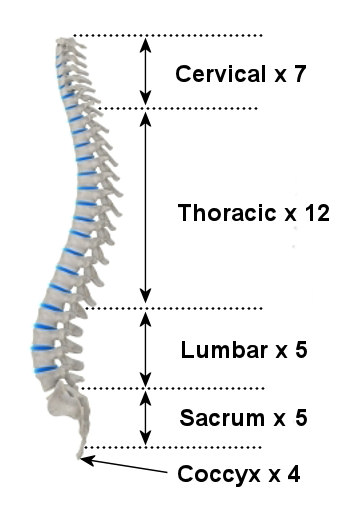The spin is made up of thick bones, ligaments and tendons, large muscles and highly sensitive nerves. It is created to hold the torso, protect the spinal cord and nerves, hold the body erect but provide flexibility and be highly mobile.
So if the back is working as designed the spine provides structure, strength, and flexibility. Unfortunately the daily habits of humans has changed drastically over the last few hundred years and our bodies have not had time to adapt this more sedentary lifestyle. If you have a desk job it is imperative that you get up often (once an hour) stretch you body and walk around. By keeping you body confined to a chair you are slowly destroying your body which is designed for movement.
If you are experiencing back pain, you will want to know what the quickest way to relief, what caused the issue, and how to prevent a recurrence.
There are 24 bones/ “vertebrae” that make up the spine (not including the lowest most rigid bones of the spine the sacrum and coccyx). Each vertebrae is assigned a number and a letter (L5 thru C7) Insert “spine 4” picture. The joints (and disk) are named by the two surrounding vertebrae (L4-L5 refers to the joint connecting the two lowest vertebrae of the lumbar region).

From top to bottom…
The cervical spine (neck)
This area of the spine is comprised of seven vertebrae (C1-C7).The upper most spin/neck holds the weight of the head and protects the spinal nerves that originate in the brain and radiate down to the rest of the body. Each of these vertebrae get smaller as they move up the spine (closer to the skull). A majority of the rotation of the cervical spine is generated from the top two vertebral joints whereas most of the flexion/extension movement is generated from the bottom two.
Neck pain is typically caused by a muscle, ligament or tendon strain (due to sudden force or straining). These injuries often heal on their own with time and physical therapy.
The thoracic spine (upper back)
The twelve vertebrae in the upper/mid back (T1 – T12) make up the thoracic spine. The attachment of the ribs at each level of the thoracic spine forms the rib-cage unit. The Thoracic spine provides stability and support to the upper back while protecting the vital organs (i.e. lungs and heart).
Injuries in the thoracic spine are not common due to the lack of mobility. Pain in this are is often due to issues with the back or shoulder muscles. t dysfunction in the upper back can produce very noticeable back pain.
The lumbar spine
The lumbar spine consists of 5 vertebrae numbered (L1-L5). The Lumbar region has a difficult job – It must provide for a great range of mobility while supporting the weight of the upper body. The lumbar spine is incredibly strong while protecting the spinal cord and nerves. At the same time, it is flexible enough to provide for motion in many different planes.
The lumbar spine is the most common area for someone to experience back pain. This is easily understood given the difficult functions this area is responsible for.
The Sacral Region
The sacral region of the spine (sacrum) contains a single bone in the adult skeleton that is formed by the fusion of 5 vertebrae during adolescence. The sacrum is a thin, triangular bone found in the lower back between the hip bones.
The Coccygeal region
The coccygeal region of the spine (coccyx) is a single bone formed by the fusion of 4 tiny vertebrae during adolescence. The coccyx is known as the human “tailbone”. The coccyx bears the weight of the body when sitting down and provides attachment points for muscles of the pelvic and gluteal regions.
